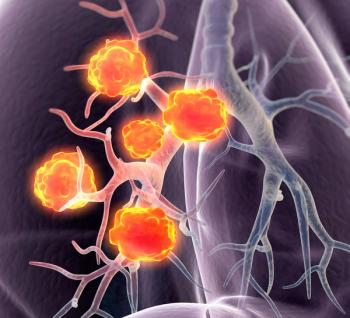
Pazopanib Improves PFS in Extensive-Disease SCLC, But Adds Toxicity
Maintenance therapy with pazopanib significantly prolonged progression-free survival in patients with extensive-disease small-cell lung cancer, but with toxicity.
Maintenance therapy with pazopanib significantly prolonged progression-free survival (PFS) in patients with extensive-disease small-cell lung cancer (ED-SCLC), according to a new study. Substantial toxicity was seen with the therapy, however, suggesting that careful selection of patients is important.
“Despite dramatic response to first-line chemotherapy, most patients with ED-SCLC experience rapid relapse or progression during the off-therapy period,” wrote study authors led by Myung-Ju Ahn, MD, of the Sungkyunkwan University School of Medicine in Seoul. “ED-SCLC might theoretically be a good candidate for maintenance therapy, given that it is a very short interval between completion of first-line chemotherapy and its subsequent disease progression, and prolongation of this interval can eventually lead to improvement in overall survival.”
The investigators conducted a phase II study of 95 patients randomized to either pazopanib (48 patients) or placebo (47 patients); all had ED-SCLC and had not progressed after 4 cycles of etoposide plus platinum therapy. The results were
The median ages in the pazopanib and placebo groups were 66.5 years and 67 years, respectively; most patients in both groups were male (83.3% and 91.5%, respectively) and were current or ex-smokers (89.6% and 87.2%, respectively). Most patients’ best response to etoposide/platinum therapy was a partial response (93.6% and 97.9%, respectively).
After a median follow-up of 30.1 months, the median PFS with pazopanib maintenance therapy was 3.7 months, compared with 1.8 months with placebo, for a hazard ratio (HR) of 0.44 (95% CI, 0.29–0.69; P < .0001). Nine patients (18.8%) receiving pazopanib achieved a PFS duration of greater than 6 months, compared with two patients (4.3%) in the placebo group (P = .027).
The median overall survival was 10.6 months with the study drug and 12.9 months with placebo, for an HR of 1.14 (95% CI, 0.74–1.76; P = .54). The authors noted that the failure to translate the PFS benefit into an OS benefit may be related to post-study treatment; 84.4% of pazopanib patients and 97.2% of placebo patients received post-study chemotherapy.
The most common grade 3 adverse events with pazopanib included thrombocytopenia (10.4%, including one grade 4), ALT elevation (10.4%), fatigue (6.3%), hypertension (6.3%), and stomatitis (4.2%). There was only one grade 3 adverse event in the placebo group (thrombocytopenia). A total of 25 patients (52.1%) in the pazopanib group required a dose reduction due to adverse events, and 4 discontinued the treatment permanently.
The authors concluded that in spite of the positive PFS result, larger phase III trials should incorporate different designs to account for the toxicity seen in this trial. “One prerequisite for future studies can be an enrichment of study population based on predictive biomarkers that will most benefit from pazopanib maintenance therapy in terms of toxicity and efficacy,” they wrote.
Newsletter
Stay up to date on recent advances in the multidisciplinary approach to cancer.



















































































